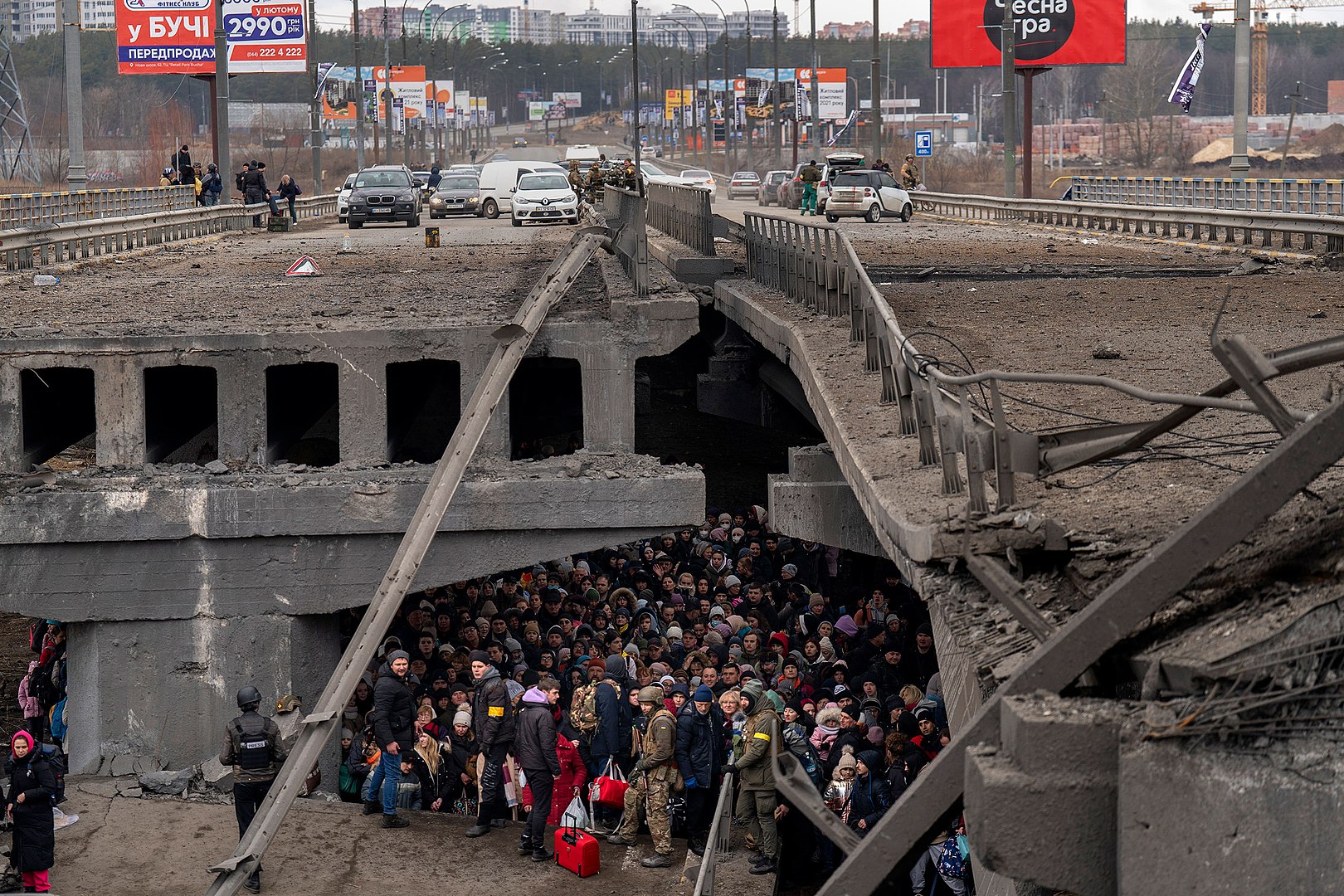The least vaccinated in Europe, war-torn Ukraine is hit hard by COVID-19
Russia’s aggression may have knocked the pandemic out of most headlines but hasn’t stopped its spread. In wartime, as during any disaster, epidemic diseases take an incredible toll. Ukraine was long viewed as a geopolitical sideshow by the US and EU, resulting in the lowest vaccination rate in Europe.
In April 2021, Ukrainian health expert and journalist Pavlo Kovtonyuk declared that ‘vaccination is not a priority in Ukraine’.1 No other country in Europe has a lower vaccination rate, and there is little chance for significant progress amidst the destruction of medical infrastructure, and indescribable human suffering.
On February 23, the eve of Russia’s full-scale invasion into Ukraine, only 36 per cent of the Ukrainian population had received their first vaccination, and a mere 35 per cent were fully immunised.2 These rates are substantially lower even than neighbouring Belarus, where the vaccination rates stand at 60% and 54%, respectively,3 despite the despot Aleksandr Lukashenka’s repeated denial of the dangers of the disease.
The reasons for the Ukrainian vaccination debacle are manifold but the current situation creates the worst possible conditions for effective pandemic control in the near future. For one, we must remember that through the past eight years, the armed conflict with the Russia-backed separatists in the Eastern Donbas region had been crippling the Ukrainian economy, and Ukraine slipped to 119th place in terms of GDP per capita out of 190 countries surveyed, rendering it the poorest country in Europe.4
I give many interviews these days. The most frequent question is: how healthcare in Ukraine is affected by the war? Well, this is how. 1/3 pic.twitter.com/jodJBbacl6
— Pavlo Kovtoniuk (@pavlokovtonyuk) March 23, 2022
A struggling public health system
COVID-19 had mercilessly exposed the weaknesses of the Ukrainian health system, as it did in all countries. In terms of their structural integrity and hygienic standards, many Ukrainian hospitals were in a perilous state.5 In March of last year, images from a hospital in the western Ukrainian city of Khust, where monstrous, rust-eaten Soviet-era washing machines struggled with the hospital laundry in front of mould-covered walls, inspired widespread dismay.
While the country survived the first wave of the pandemic comparatively well thanks to a strict lockdown, the second wave hit Ukraine much harder in autumn 2020. The testing and contact tracing system was highly inefficient. In Chernivtsi, doctor Olha Kobevko tried to ring the alarm by broadcasting videos from her hospital: patients could often only receive care if they brought their own oxygen tanks, and official statistics were fudged. The local administration reacted with intimidation, Kobevko was interrogated by the police.
There were also other flaws reminiscent of the chaos of the 1990s. In a Covid hospital in the eastern town of Valky, for instance, medical staff had not received their salaries for three months by July 2021.6 Doctors and nurses joined by army veterans eventually blocked the main road from Kyiv to Kharkiv as a sign of protest.
From the outset of the Covid pandemic, open cynicism characterized the political response. At the end of March 2020, the then-minister of health Illya Yemets stated in a TV interview that life expectancy for men in Ukraine was unfortunately only 65 years – the minister himself was 64 – and that he had therefore instructed his financial experts to allocate funds ‘for the living’, ‘and not for corpses’ (in fact, in 2019 the average Ukrainian male died at the age of 66.9 years,7 putting the country just ahead of Rwanda and Botswana).
It was widely accepted in Ukraine for the political elite to seek medical treatment abroad in cases of emergency. Probably the most prominent Ukrainian victim of the pandemic was the glamorous mayor of Kharkiv, Hennadii Kernes, who had been confined to a wheelchair since an assassination attempt in 2014, was transferred to the Charité hospital in Berlin when he contracted Covid. He died there in December 2020.
Conflicting institutions
Covid-19 struck Ukraine in the middle of an unfinished process of healthcare reform, which was primarily aimed at improving primary care by means of introducing family doctors.8 Another central element was the creation of an independent drug purchasing agency to combat the endemic trade in counterfeit medicines.9 The reform package showed some initial success, but there are now two parallel healthcare structures – the purchasing agency and the ministry – which clash more often than they collaborate. This dysfunction then resulted in complications and delays in negotiations with vaccine producers.
By the time the Ukrainian government signed a contract with the Chinese manufacturer Sinovac on 30 December 2020, many other countries had already started their vaccination campaigns. Apart from the significantly lower efficacy of that product compared to other vaccines, the 1.9 million doses slated for delivery from March 2021 were a mere drop in the ocean for a country with a population estimated at 41 million.10 For the Chinese, the deal was nothing more than a symbolic show of presence, which would not threaten Russian geopolitical interests in the region.11
Failing vaccine diplomacy
The failure of the initial Ukrainian vaccination campaign was due in a significant part to the country’s dramatic weakness in the realm of ‘vaccine diplomacy’, due to four major factors.
First, Ukraine gave away its most important trump card right at the outset. While Serbia, another non-EU country, played the geopolitical game very cleverly, and obtained vaccines from both China and Russia as well as from the EU very early on, the Ukrainian government categorically refused to approve the Russian Sputnik vaccine. Foreign Minister Dmytro Kuleba even spoke of it as a ‘hybrid weapon’ of the Kremlin’s devising.12 As understandable as this stance may have been even before the Russia’s full-scale attack on Ukraine, it nevertheless weakened the Ukrainian negotiating position enormously.
The issue was also immediately taken up by the pro-Russian opposition. Ukrainian oligarch and Putin confidant Viktor Medvedchuk (who fled the country when the war started) was already banging the drum for Sputnik V in the media as early as January 2021,13 and spreading unconfirmed reports that a pharmaceutical company in Kharkiv had applied for a production licence for the Russian vaccine. Such talk was extremely unpleasant for the government and may have contributed to an ensuing, legally dubious presidential decree shutting down three television stations associated with Medvechuk and widely seen as pro-Russian.14
Second, Ukraine could not count on any support from the European Union. The Western Balkan states Bosnia-Herzegovina, Kosovo and Northern Macedonia, which like Ukraine had encountered great difficulties in securing vaccines on their own at first, received their first doses in May as part of a so-called ‘pre-accession aid’ package directed at for EU accession candidates.
Vienna took over the interim financing for this move,15 because Austria has a strong vested interest in containing the virus in this region given the close contact between the Austrian and Western Balkan populations. But from the EU’s point of view, Ukraine was then neither an actual nor a potential candidate for accession,16 thus the country was also left out from of programme.
Third, Ukraine initially lacked a reliable bilateral partner in the EU. The Republic of Moldova, which is comparable to Ukraine in many social and economic respects, received significant quantities of the AstraZeneca vaccine from Romania in Spring of this year.17 Moreover, a large part of the Moldovan population also has Romanian citizenship and can therefore be vaccinated on a visit to their western neighbour. In the border region of Iași, ‘vaccination marathons’ for Romanian-Moldovan dual citizens have been held since last May.18
It was only later, in the summer of 2021, that Ukraine became the beneficiary of roughly 3 million AstraZeneca doses donated by EU-member states, but many of them ended up ultimately unadministered.19
Ukraine was considered a geopolitical sideshow
Fourth, and finally, hopes of direct support from the USA proved illusory. Ukrainian President Volodymyr Zelensky had asked the United States for assistance already in December 2020,20 raising the issue in a telephone conversation with his counterpart Joe Biden, but without achieving any concrete commitments. One reason for this was surely the disastrous boom of the Delta variant in India, which put the issue of Ukraine on the back burner.
Not even the threat posed by Russian troop deployments on the Ukrainian border as early as in April 2021 changed the situation. The first 25 million vaccine doses donated by the United States overseas went to India, Indonesia, Taiwan and Thailand, among others.21 This made it abundantly clear that, apart from humanitarian considerations, the Biden administration was primarily concerned with containing Chinese influence in Asia. Ukraine was a geopolitical sideshow a year ago.

Children sheltering in a Kyiv basement on 1 March 2022. Photo by the Ministry of Internal Affairs Ukraine via Wikimedia Commons.
The only real support for the crisis-ridden country was the WHO’s Covax programme, which distributes vaccines free of charge to low- and lower-middle-income countries. Ukraine has thus far received only a bit over a million doses of vaccine from AstraZeneca and around 590,000 from Pfizer – a bit more than half of the total amount allocated.22 Of course, Covax could not substitute for a national vaccination strategy, because the programme’s stated aim was the vaccination of ‘at least 20 percent’ of the population in the world’s poorest countries.23
It was only in April and May 2021 that the Ukrainian government finally managed to conclude two contracts with Pfizer. A total of 20 million vaccine doses were to be administered by the end of the year. The big unknown was willingness to vaccinate, but polls taken in April 2021 showed that more than half of the population wanted to take the jab.24 In hindsight, the poll proved to be an overly optimistic snapshot. As vaccines became available, Ukraine clearly followed the path of eastern EU-member states like Romania, where the inoculation rates remained very similarly low, even despite the early availability of vaccines.
Hit hard by Delta
As unanimously predicted by experts, the Delta variant hit Ukraine largely unprepared. Cases skyrocketed in October and November 2021, hospitals reeling throughout the country. In late October, Ukraine had the fourth highest absolute death rate from Covid worldwide, after the US, Russia and Romania.25 The emerging footage was shocking, unlike anything seen in Western media. Journalists from multiple TV channels went straight into the hospitals: they filmed obese patients treated in intensive care units, and interviewed others wearing oxygen masks, barely able to speak and struggling to breathe.26 It was reported that all these people were unvaccinated.
Given the low level of vaccine uptake in the middle of the Delta surge, the Ukrainian government issued a vaccine mandate for teachers and officials in November 2021.27 In early December, president Zelensky announced a bonus payment of 1,000 hryven (32.50 euros) for fully vaccinated Ukrainians.28 The booster campaign deemed imperative to confront the Omicron variant did not start in Ukraine until early January 2022.29
Under siege, epidemics are the greatest danger
The last nationwide statistics of new infections are from February 24, the day of the Russian invasion. With the start of the war, Covid almost completely disappeared from Ukrainian news. It is all too understandable that, under the very clear threat of missiles and bombs, covid has dropped out of the news cycle.
Nevertheless, the virus has not disappeared with the outbreak of the war. In bomb shelters or in subway stations, in overcrowded train cars and in emergency shelters: people are exposed to the virus without protection, and have no means to socially distance, no access to proper, medically advised sanitation. Under these circumstances, there is no option for testing and quarantine.

Civilians and soldiers seeking shelter under a bridge in Kyiv on 5 March 2022. Photo from the Ministry of Internal Affairs Ukraine on Wikimedia Commons.
Beside the increased risk of infection, there are several other aspects that compound the vulnerability of the population.
First, given the low vaccination rate, a larger number of people will become seriously ill, even from the generally less dangerous Omicron variant. Secondly, it can be assumed that the devastating general supply situation also puts people with mild symptoms in danger. People who have to stay in basements for days or weeks without heating, hot water or adequate food supplies are certainly less able to cope with an infection.
The supply of medicines has collapsed in many places. This affects the chronically ill even more severely, many of whose treatment can often no longer be ensured. And the infectious patients who end up hospitalized, exacerbate the already dramatic situation in the still intact hospitals, already overcrowded with the wounded and injured.
From the beginning of the war to March 13, as many as 13,782 covid patients were treated in Ukrainian hospitals, the bulk of them presumably in the western and central regions of the country, which have yet been less affected by the war. Testing continues where possible. Finally, the already slow progress of vaccination is faltering in many regions. But despite all these factors, 175,000 vaccine doses have been administered since the beginning of the war.30 Whether Ukrainian refugees making their way towards EU, will accept vaccination offers, will largely depend on local legislation and is difficult to assess at this time.
This article is based on one published on 29 June 2021 on the Transformative Blog of Eurozine’s academic partner RECET, the Research Centre for the History of Transformations.
Pavlo Kovtonyuk, Треба просто почати вакцинувати [One just has to start vaccinating] , Українська Правда, 6 April 2021, available at https://life.pravda.com.ua/columns/2021/04/6/244469/ (last accessed on 21 March 2022).
Our World in Data, ‘Covid-19 Vaccinations: Ukraine’, available at https://ourworldindata.org/covid-vaccinations?country=UKR#country-by-country-data-on-covid-19-vaccinations (last accessed on 21 March 2022).
Our World in Data, ‘Covid-19 Vaccinations: Belarus’, available at https://ourworldindata.org/covid-vaccinations?country=~BLR#country-by-country-data-on-covid-19-vaccinations (last accessed on 21 March 2022).
Wikipedia, ‘List of Sovereign States in Europe by GNI (nominal) per capita’, available at https://en.wikipedia.org/wiki/List_of_sovereign_states_in_Europe_by_GNI_(nominal)_per_capita (last accessed on 1 March 2022); Wikipedia, ‘List of countries by GNI (nominal) per capita’, available at https://en.wikipedia.org/wiki/List_of_countries_by_GNI_(nominal)_per_capita#Lower-middle-income_group (last accessed on 20 March 2022).
Електронна книга скарг України, Інфекційне відділення у Одеській лікарні у ганебному стані: місцеві просять допомоги, [The infectious deceases ward of an Odesa hospital is in a deplorable state: Locals ask for help], 13 May 2020, available at https://reaction.org.ua/complaints/infekciyne-viddilennya-u-odeskiy-likarni-u-ganebnomu-stani-miscevi-prosyat-dopomogi (last accessed on 1 March 2022).
Tetyana Fedorkova, Marharyta Dezhkina, ‘”Врятуємо Валківську лікарню”: на Харківщині протестують медики [‘Let’s Save Valky Hospital’: Doctors protest in the Kharkiv Region], Suspil'ne, 24 July 2021, available at https://suspilne.media/150161-vratuemo-valkivsku-likarnu-na-harkivsini-protestuut-mediki/ (last accessed on 1 March 2022).
Laenderdaten, ‘Comparison of Average Life Expectancies’, available at https://www.laenderdaten.info/lebenserwartung.php (last accessed on 1 March 2022).
Ukraine Crisis Media Centre, ‘Was man über die Gesundheitsreform in der Ukraine wissen muss’ [What You Need to Know About Healthcare Reform in Ukraine], 11 September 2017, available at https://uacrisis.org/de/60230-need-know-healthcare-reform-ukraine (last accessed on 1 March 2022).
BPB, ‘Analyse: Gerade noch rechtzeitig reformiert? Wie das ukrainische Gesundheitssystem mit der Covid-19-Pandemie zurechtkommt’ [Analysis: Reformed just in time? How the Ukrainian healthcare system is coping with the Covid-19 pandemic], 30 March 2021, available at https://www.bpb.de/themen/europa/ukraine/330900/analyse-gerade-noch-rechtzeitig-reformiert-wie-das-ukrainische-gesundheitssystem-mit-der-covid-19-pandemie-zurechtkommt/ (last accessed on 1 March 2022).
Міністерство охорони здоров'я України, ‘МОЗ уклало договір на поставку 1 млн 913 доз вакцини проти COVID-19 компанії "Сіновак"’, [Ministry of Health of Ukraine concluded a contract for the supply of 1,913 million vaccine doses against Covid 19 of the company "Sinovac"], 30 December 2020, available at https://moz.gov.ua/article/news/moz-uklalo-dogovir-na-postavku-18-mln-doz-vakcini-proti-covid-19-kompanii-sinovak (last accessed on 1 March 2022).
Maria Varenikova, ‘In Vaccine Geopolitics, a Great Game Played with Ukrainians’ Health’, New York Times, 9 Janauary 2021, available at https://www.nytimes.com/2021/01/09/world/europe/covid-vaccines-ukraine.html (last accessed on 1 March, 2022).
Ukrinform, ‘Кулеба: Російська вакцина від коронавірусу – це гібридна зброя проти України’, [Kuleba: The Russian corona virus vaccine is a hybrid weapon against Ukraine], 29 December 2020, available at https://www.ukrinform.ua/rubric-polytics/3162911-kuleba-rosijska-vakcina-vid-koronavirusu-ce-gibridna-zbroa-proti-ukraini.html (last accessed on 1 March 2022).
Ibid.
Denis Trubetskoy, ‘Ukraine schaltet prorussische Fernsehsender ab’, [Ukraine shuts down pro-Russian TV channels], MDR, 8 February 2021, available at https://www.mdr.de/nachrichten/welt/osteuropa/politik/ukraine-schaltet-prorussische-tv-sender-ab-100.html (last accessed on 1 March 2022).
Adelheid Wölfl, ‘EU stellt 651.000 Impfdosen für Westbalkan zur Verfügung’, [EU provides 651,000 vaccine doses for Western Balkan], Der Standard, 20 April 2021, available at https://www.derstandard.de/story/2000125955939/lieferung-ab-mai-eu-stellt-651-000-impfdosen-fuer-westbalkan (last accessed on 21 March 2022).
European Union, ‘Instrument für Heranführungshilfe (IPA)’ [Instrument for Pre-Accession Assistance], available at https://ec.europa.eu/regional_policy/de/funding/ipa/ (last accessed on 1 March 2022).
Digi 24, ‘România a trimis 132.000 de doze de AstraZeneca pentru Republica Moldova’
[Romania has send 132,000 doses of AstraZeneca to the Republic of Moldova], 17 April 2021, available at https://www.digi24.ro/stiri/actualitate/romania-a-trimis-132-000-de-doze-de-astrazeneca-pentru-republica-moldova-1498879 (last accessed on 1 March 2022).
Violeta Cincu, ‘Cetățenii Republicii Moldova și studenții în topul vaccinărilor la Maratonul UMF Iași’ [Citizens of the Republic of Moldova and Students Come Top in Vaccinations Marathon at the UMF Iași], RFI, 17 May 2021, available at https://www.rfi.ro/social-134039-cetateni-republica-moldova-studenti-top-vaccinari-maraton-umf-iasi (last accessed on 1 March 2022).
Iryna Sitnikova, ‘KSE: в Україні є 3 млн доз AstraZeneca, які можуть не встигнути використати повністю. Що робити?’ [KSE: in Ukraine are 3 millions doses of AstraZeneca that may not all be used in time. What do to?], hromadske, 14 September 2021, available https://hromadske.ua/posts/kse-v-ukrayini-mozhut-zipsuvatisya-3-mln-doz-vakcin-astrazeneca-persh-nizh-yih-vikoristayut-sho-z-cim-robiti (last accessed on 21 March 2022).
Kyodo News, ‘1st Batch of US-donated Vaccines go to India, Taiwan, Others’, 4 June 2021, available at https://english.kyodonews.net/news/2021/06/5103b835f454-1st-batch-of-us-donated-vaccines-to-go-to-india-taiwan-others.html (last accessed on 1 March 2022).
BBC, ‘Чому США не поспішають допомагати Україні з вакцинами’ [Why the United States is in No Hurry to Help Ukraine With Vaccines], 4 May 2021, available at https://www.bbc.com/ukrainian/press-review-56981710 (last accessed on 1 March 2022).
Gavi, ‘Covax Vaccine Roll-Out: Ukraine’, available at https://www.gavi.org/covax-vaccine-roll-out/ukraine (last accessed on 1 March 2022).
WHO, ‘Covax’ home page, available at https://www.who.int/initiatives/act-accelerator/covax (last accessed on 1 March 2022).
Unicef, ‘Більшість українців готові вакцинуватися проти COVID-19 — дослідження ЮНІСЕФ’ [Most Ukrainians are ready to be vaccinated against COVID-19: a UNICEF study], 22 April 2021, available at https://www.unicef.org/ukraine/прес-релізи/більшість-українців-готові-вакцинуватися-проти-covid-19-дослідження-юнісеф (last accessed on 1 March 2022).
Ukraine Crisis Media Centre, ‘COVID-19: Die Ukraine am Rande des Kollaps’ [Covid-19: Ukraine at the Brink of the Collapse], 23 October 2021, available at https://uacrisis.org/de/covid-19-die-ukraine-am-rande-des-kollaps (last accessed on 1 March 2022).
Yuliia Zhukova, ‘Не уявляла цього пекла'. В Україні переповнені COVID-лікарні інфіковані пацієнтки закликають вакцинуватися –відео’, ['I did not imagine this hell' In Ukraine Covid-hospitals are overcrowded, infected patients call for getting vaccinated – Video], Radio Svoboda, 26 October 2021, available at https://www.radiosvoboda.org/a/video-koronavirus-ukraina/31530657.html (last accessed on 21 March 2022).
Nadiya Konstantinova, ‘Немає щеплення – немає праці. Невакцинованих педагогів і чиновників відсторонять від роботи’ [No Vaccination, No Work: Unvaccinated Officials and Teachers to be Fired], КОРОНАВІРУС, 7 November, 2021, available at https://www.radiosvoboda.org/a/nevaksynovanyh-pedahohiv-i-chynovnykiv-vidstoroniat-vid-roboty/31549994.html (last accessed on 1 March 2022).
BBC, ‘В Україні новий рекорд смертей від Covid-19’ [Ukraine Hits New Record Covid-19 Death Rate], 16 November 2021, available at https://www.bbc.com/ukrainian/news-59302846 (last accessed on 1 March 2022).
Viktoriia Eysmunt, Третя доза: Все про бустерну дозу щеплення від ковіду в Україні, [The third dose. Everything about the booster dose of the Covid vaccination in Ukraine], Zaxid.net, 16 December 2021, available at https://zaxid.net/tretya_doza_vaktsini_ukrayini_hto_koli_zmozhe_vretye_shhepitisya_n1532334 (last accessed on 1 March 2022).
Dar''ya Nyn'ko, Коронавірус: як Україна бореться з COVID-19 в умовах війни [Corona Virus: how Ukraine is battling Covid 19 in the conditions of war], Deutsche Welle, 17 March 2022, available at https://www.dw.com/uk/koronavirus-yak-ukraina-boretsia-z-covid-19-v-umovakh-viiny/a-61150323 (last accessed on 21 March 2022).
In collaboration with
Newsletter
Subscribe to know what’s worth thinking about.
Related Articles

For those who suffered the consequences of Yalta’s division of Europe, the Helsinki Final Act brought grounds for optimism. Today, as Russia’s regressive war on Ukraine reopens old conflicts, it stands as a monument to European modernity.

Artist Marharyta Polovinko’s creativity persisted in a tormented form through her experiences as a soldier on the Ukrainian frontline. The words of a recently called-up fellow creative and young family man provide a stark reminder that the Ukrainian military is buying Europeans time.





